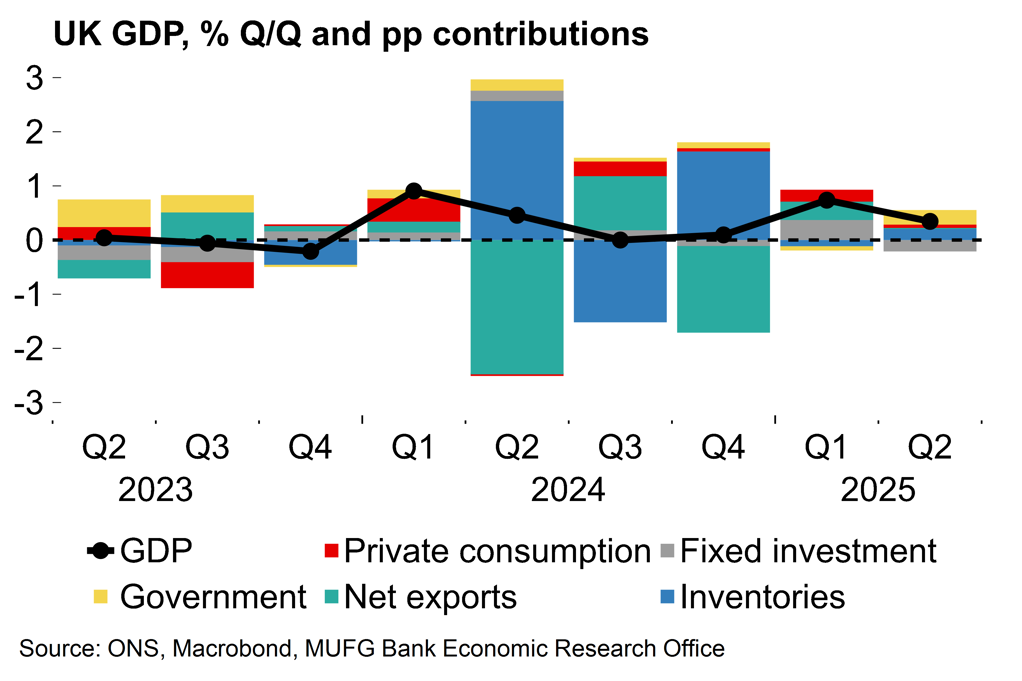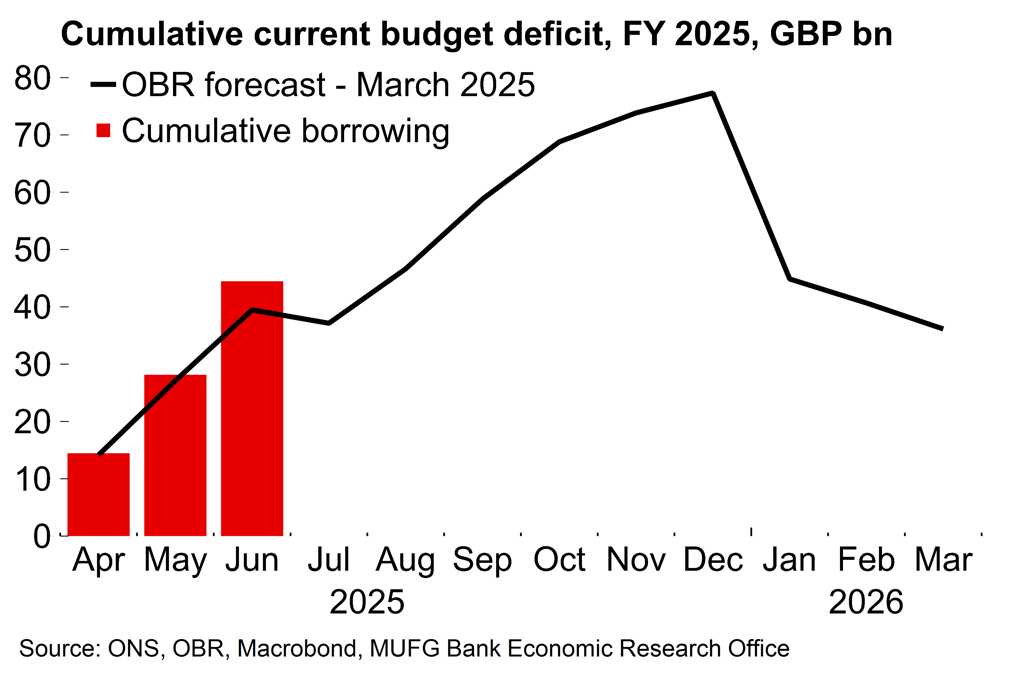- UK GDP surprised to the upside in Q2 with growth of 0.3% Q/Q – a sharp slowdown from the Q1 figure, but not as bad as feared due to strong support from government capex and consumption. We are now tracking 2025 annual growth at 1.4%, up from 1.2% previously, with solid monthly data for June suggesting reasonable momentum into H2.
- The problem is that the public clearly recognises that the government is in a bind over its fiscal policy. Survey data suggests that speculation around possible consolidation measures at the Budget will increasingly dominate the outlook and weigh on activity. It’s hard to see scope for a meaningful pick-up in growth over coming quarters, even as the distortions from US tariffs and domestic policy decisions fade. We’re set to revise our 2026 forecast down accordingly in our next update.
Government activity helped to prop up the UK economy in Q2
UK Q2 growth came in at 0.3% Q/Q. That figure won’t exactly set pulses racing but this is a decent upside surprise (consensus: 0.1% Q/Q). The economy managed to eke out reasonable growth despite the reversal of the various factors which boosted Q1 growth (e.g. US frontloading, the stamp duty deadline and possibly some residual seasonality in the numbers).
The details were less encouraging. The expenditure breakdown showed household consumption expanded by 0.1% Q/Q, down from 0.3% in Q1. More concerning was business investment, which fell by 4.0% Q/Q and more than reversed the 3.9% rise in Q1 (which was bolstered by aircraft investment). These numbers are volatile and prone to revision, but business investment is stagnant (just 0.1% Y/Y) and uncertainty around global trade and fiscal consolidation in the autumn are likely to continue to weigh on investment decisions.
This weakness in private sector demand (-0.5% Q/Q) was offset by positive contributions from the government sector, both in consumption (+0.27pp) and capex (+0.21pp). Remember that last year’s budget was ultimately an expansionary affair with “one of the largest fiscal loosenings of any fiscal event in recent decades” (in the words of the OBR). This looks like the first sign of that support coming through, and it offsets a weaker picture elsewhere.
Externally, the frontloading reversal story was clearly visible with exports to the US at the lowest level since February 2022. Despite this there was a flat contribution from net exports (i.e. 0.0pp) with services exports estimated to be up 2.9% Q/Q.
In terms of the outlook, the healthy number for June (0.4% M/M) means there’s a solid carryover of 0.2pp in Q3 growth. The jobs data earlier this week was also firmer than expected (see here) – and based on recent patterns it’s plausible that the small fall in payroll employment for June will be revised away in later estimates. The general picture of gradual labour market loosening remains, but recent numbers have been less alarming than feared.
We will publish our full forecasts in coming weeks but will likely stick with a broadly unchanged quarterly profile through the rest of the year (with growth at 0.2-0.3% Q/Q). That mechanically lifts our 2025 annual average figure from 1.2% to 1.4%.
Government support helped to cushion the slowdown after the fast start to the year...

...but the borrowing overshoot means that fiscal consolidation is looking likely

Speculation around the Budget could increasingly weigh on activity
Today’s GDP figures will be welcome news for the chancellor. Growth of around 1.4% would be a better outcome than the OBR was expecting in March (1.0%). Yet efforts are still likely to be needed to restore some headroom to the government’s fiscal rules after higher-than-expected interest costs and the likely downgrade to the optimistic official outlook projections further ahead (the OBR has 1.9% next year, which is well above consensus).
Still, it’s clear that the government has essentially propped up UK activity in Q2. Countercyclical support can certainly be a good thing when high uncertainty is weighing on investment and spending decisions – fiscal multipliers tend to be higher during periods of slack. The surge in government capex (6.9% Q/Q, the highest rate in four years) is especially welcome.
The trouble is that the government is doing this in a constrained fiscal environment and much of that uncertainty relates to its own domestic policy rather than tariffs. The public clearly recognises that the government is in a bind over its fiscal policy and expects consolidation efforts in the autumn Budget. So it’s all looking a bit Ricardian: the latest consumer confidence release noted that some households are “building contingency funds” amid anxiety around possible measures. Investment surveys also remain tepid, which points to headwinds for both spending and capex over coming months. Speculation around the Budget will continue to dominate the H2 outlook and, we suspect, weigh on growth over coming months. With the likelihood of weak momentum into next year, we are revising our 2026 forecast down accordingly, to 1.2%.
